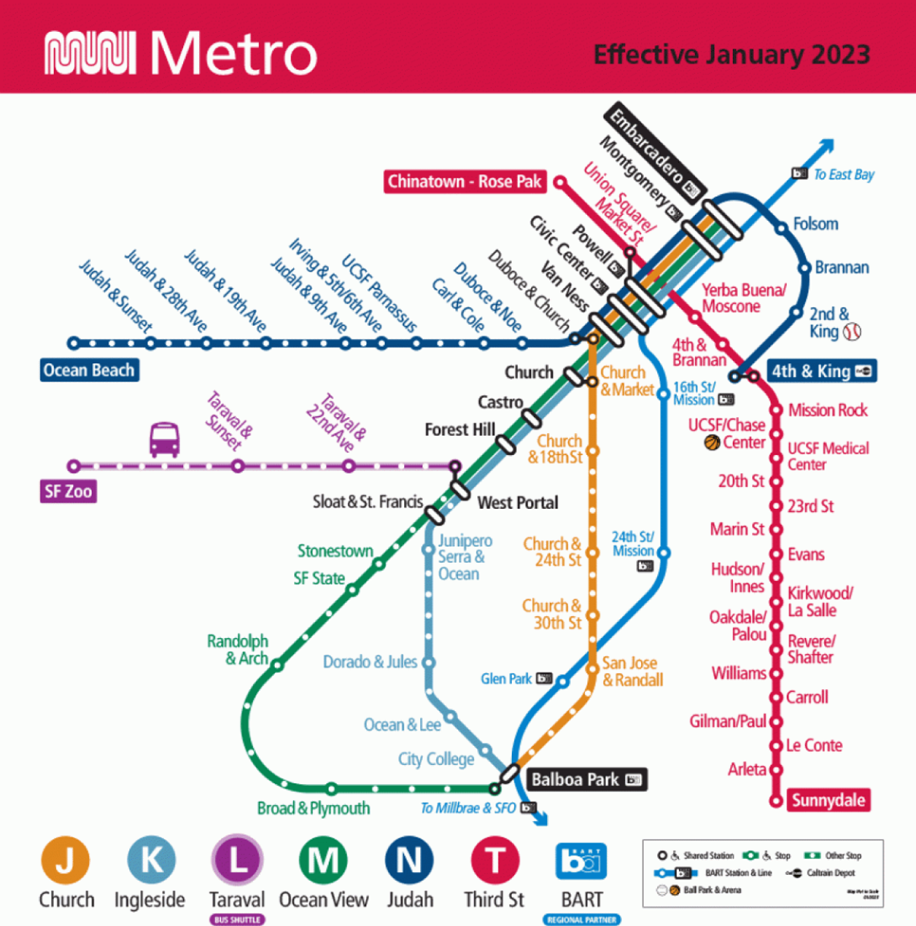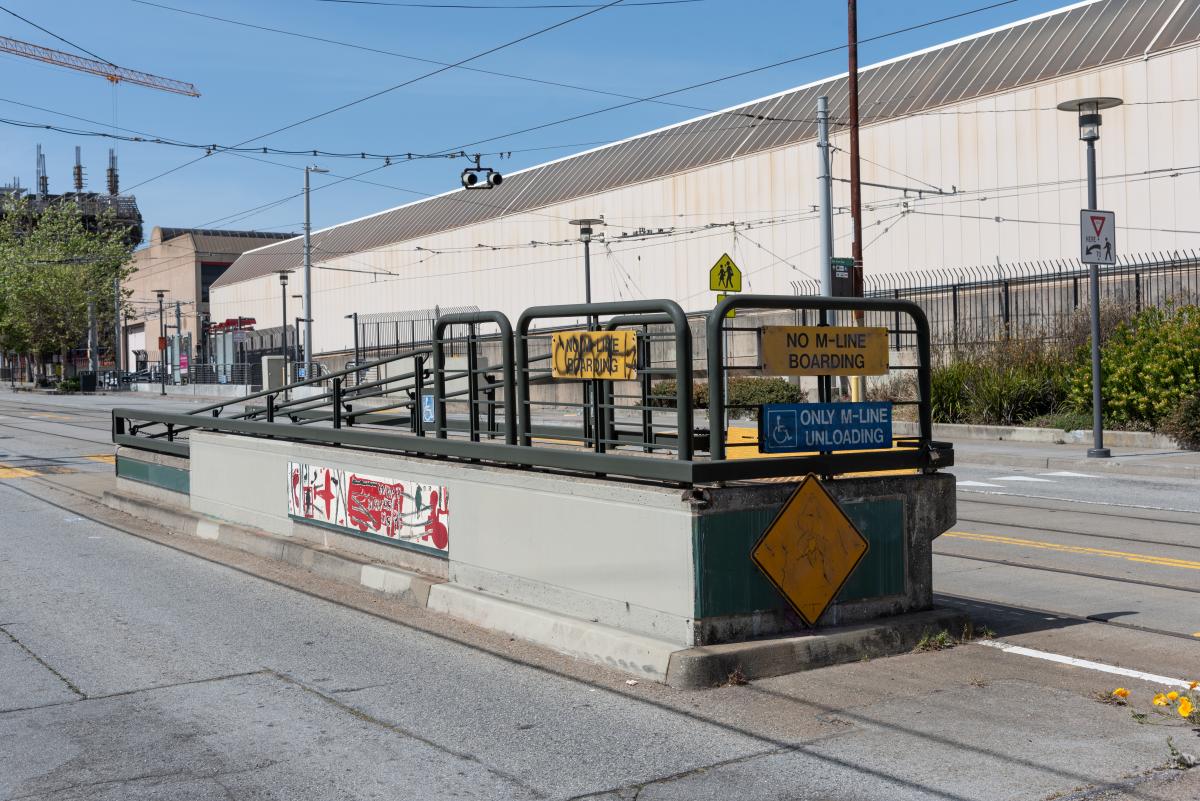Key Takeaway: Riders who use mobility devices are not able to board or alight at surface stops without wheelchair accessible islands. Riders would benefit from the construction of six additional accessible stops identified by previous planning work. Long-range planning decisions made as part of the Muni Metro Core Capacity study may provide an opportunity to deploy all low-floor rail vehicles at surface stops and make the entire system accessible.
About Surface Rail Stops
Surface stops are above-ground light rail stops located along transit routes, most frequently seen in neighborhoods in the western and southern parts of San Francisco. They range from flag stops where the train stops in the street, to stops with small narrow islands, which are not accessible to wheelchair users, to "mini-high" and fully accessible stops. Historically, none of the surface rail stops was built to accommodate passengers with assistive mobility devices.
Accessible surface stops that can accommodate passengers using wheelchairs and other mobility devices are now located at regular intervals along the routes and at major destinations such as schools and hospitals at transfer points and key destinations. Muni's light rail vehicle routes currently serve 122 stops, 63 of which are accessible. The F-line streetcar serves 31 stops, 24 of which are accessible.
Figure 1. Muni Metro Map showing Accessible Stops

Types of Accessible Surface Rail Stops
Fully Accessible Surface Rail Stops: Fully accessible surface stops are generally low-level island stops with a ramp up to a small high-level wayside platform for those who need level boarding. These are served by raising the stairs at the front door of the train next to the raised portion for level boarding and alighting. On the T Line all surface stops are fully wheelchair accessible, with underground stations or high platforms that provide level boarding at all doors. On the M Line, the platforms at Stonestown and San Francisco State are high-level platforms. Platforms at the end of the J and K line at Balboa Park station also provide fully accessible level boarding at all doors.
Figure 2. Fully Accessible Boarding Platform on the T line at Arleta Ave and Bayshore Blvd

"Mini High" Accessible Surface Rail Platforms: Due to roadway constraints, there are some accessible platforms that are separate from the low-level boarding island. We call these "mini-highs." On the J Line, for example, the accessible inbound platform on Church St & 24th Street is on the far side of Church and Elizabeth, while the low-level boarding island is nearside at Church and 24th. At these locations, directional signs are installed on the sidewalk adjacent to the boarding island to indicate the accessible platform’s location. Stop locations with separate boarding islands and platforms are not always ideal as they can be confusing for passengers and operators. However, it is the best option if a fully accessible boarding platform is not feasible.
Figure 3. Accessible "Mini High" Boarding Platform on San Jose Avenue

Accessible Text for Figure 3.
The History of Reconstructing Surface Rail Stations to be Accessible
While Muni had already embarked on providing accessibility to stops along the surface portion of the old streetcar lines beginning in 1983, following the passage of the ADA in 1990, Muni was required to submit a plan to the FTA that identified locations where wheelchair accessible surface light rail stops, referred to as “key stations,” could be constructed.
ADA key station locations were identified on the J, K, L, M and N lines and on Market St to provide accessibility to the historic streetcars on the F Line on Mid-Market street. Analysis identified 41 key station locations. The key stops identified were both underground stations and surface locations and included 18 stops that were already accessible but required modifications. To date, all 41 key station locations have been constructed or modified to meet accessibility requirements, which is a true success for access for the agency.
The planning process also identified 16 “2nd tier” locations where providing accessibility should be considered after the initial surface key stations were constructed. Accessible platforms serving inbound and outbound travel have been constructed at five of the sixteen 2nd tier locations.
A feasibility study conducted by the SFMTA in 2014 found that accessible platforms were feasible at or near eight (8) more of the recommended locations. The L Taraval Improvement Project built inbound and outbound accessible platforms at two of the locations identified in the 2014 feasibility study. While two of the 2nd tier locations were found to be infeasible, and no alternate locations have been identified, the remaining six may be constructed in conjunction with upcoming Muni Forward projects. The SFMTA has also constructed accessible light rail stops at one location, Judah & 28th Avenue, that was not on the 1st or 2nd Tier list but was identified as feasible in a 2017 SFMTA study of potential accessible surface stop locations.
The SFMTA has constructed all identified locations except two that were deemed infeasible. Six remain a priority for upcoming Muni Forward projects: Church & 15th St; San Jose & Nantucket/San Jose & San Juan, West Portal & 14th; Carl & Stanyan; Judah & 31st; and Judah & 43rd.
Accessible Station Criteria
The agency developed a list of Tier 1 and Tier 2 Accessible Surface Rail locations using the following criteria:
- Stations where passenger boardings exceed average passenger boardings on the rail system by at least 15%, unless such a station is close to another accessible station.
- Transfer stations on rail lines or between rail lines.
- Major interchange points with other transportation modes, including stations connecting with major parking facilities, bus terminals, intercity or commuter rail stations, passenger vessel terminals or airports.
- End stations, unless the end station is close to another accessible station; and
- Stations serving major activity centers, such as employment or government centers, institutions of higher education, hospitals or other major healthcare facilities, or other facilities that are major trip generators for individuals with disabilities.
Continuing the Work to Upgrade Surface Rail Station Accessibility
Moving forward, the agency is committed to the continued assessment of the 61 remaining stops that are not currently accessible and determining if and how we can fill gaps in the system with accessible platforms at those locations.
In May 2024, the Federal Transit Administration selected the SFMTA to be funded with $4.6 million to construct platforms, wheelchair ramps, and make other improvements that focus on accessibility at five Muni light rail stops on the J- Church line and three Muni stops on the M-Ocean View line.
These system enhancements will increase the number of surface-rail stations with level boarding — improving accessibility for the thousands of residents and visitors with disabilities who rely on Muni to get around the city safely and efficiently.
The stop locations that will benefit from these accessibility improvements are:
- M Ocean View terminus final outbound stop at the San Jose Ave./Niagara Ave.
- M Ocean View inbound stop at 19th Ave./Monticello St. (new stop location from stop consolidation).
- M Ocean View outbound stop at 19th Ave./Randolph St. -north (new stop location from stop consolidation).
- J Church outbound stop at San Jose Ave./Santa Rosa Ave.
- J Church inbound stop at San Jose Ave./Santa Ynez Ave.
- J Church outbound stop at San Jose Ave./Santa Ynez Ave.
- J Church inbound stop at Church St./Duboce Ave.
- J Church outbound stop at Church St./Market St.
Short-Term Upgrades
To help the SFMTA deliver Muni Forward transit priority improvements even faster, the SFMTA Board approved the Transit Priority Quick-Build Program in February 2020. The Transit Quick-Build Program focuses on reducing needless delay to transit riders using proven, fast-to-implement solutions. Some projects are as simple as painting a curb, moving a bus stop or adding a traffic sign.
Improvements can be implemented following public outreach and a public hearing, without requiring additional approval by the SFMTA Board. This can get projects on the ground months or even years faster than the current process. Accessibility and safety improvements part of transit quick-builds include new or widened raised concrete islands to better protect riders and improve the path of travel, new curb ramps, and added amenities like shelters.
Long-Term Upgrades
To prioritize the remaining inaccessible stops, the agency will need to develop further criteria (including technical and financial feasibility) and also consider long-range plans to increase Muni’s core capacity. Long-range planning considerations include if and where we will need to accommodate three-car trains and whether the agency will operate a single fleet or a mixed fleet between above-ground and below-ground stations. If the agency will eventually operate separate trains above ground than it does below ground, we could acquire low-floor vehicles and make more of the system accessible without extensive construction to existing stops.